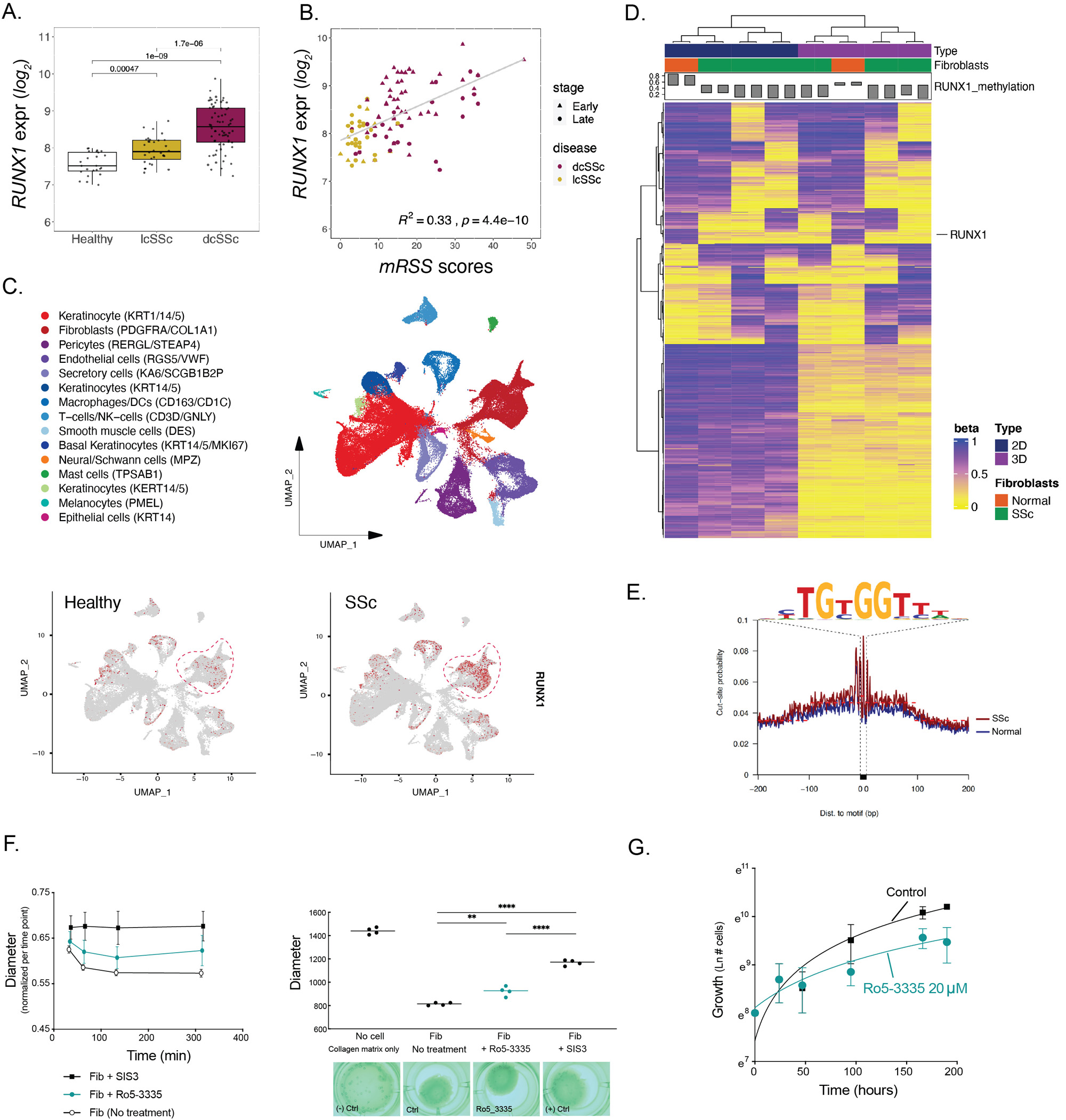Session Information
Date: Monday, November 13, 2023
Title: (0934–0964) Systemic Sclerosis & Related Disorders – Basic Science Poster
Session Type: Poster Session B
Session Time: 9:00AM-11:00AM
Background/Purpose: Runt-related transcription factor 1 (RUNX1) is a member of the core-binding factor family that regulates proliferation, differentiation, and cell survival in multiple cell lineages. Activation of RUNX1 in fibroblasts has been implicated in wound healing and a network analysis of transcription factor (TF) activity suggested that it is a key regulator in diffuse cutaneous systemic sclerosis (dcSSc) skin. Here, we analyze the specific contribution and function of RUNX1 in systemic sclerosis (SSc) dermal fibroblasts.
Methods:
Results: Analysis of gene expression data from a cohort of 124 individuals revealed significant over-expression of RUNX1 in skin biopsies of SSc patients. Correlation analysis demonstrated significantly increased expression of RUNX1 and in patients with higher modified Rodnan Skin Score (mRSS) (r2= 0.33, p-value = 4.4e-10) (Fig 1A, B). Analysis of scRNA-seq data from SSc and control skin showed enrichment of RUNX1 in PDGFRA1/COL1A1 expressing fibroblasts subpopulations (Fig 1C). Analysis of scRNA-seq and scATAC-seq of in vitro 3D skin-like tissues showed increase expression and RUNX1 binding site accessibility in ECM producing fibroblasts. DNA methylation profiling of isolated fibroblasts from dcSSc and healthy donors demonstrated hypomethylation of RUNX1 in SSc fibroblasts (Fig 1D). Bulk ATAC-seq of dcSSc fibroblasts showed increased accessibility of RUNX1 chromatin binding (Fig 1E), which facilitates TF binding. Inhibition of RUNX1 activity by Ro5-3335 significantly reduced the ability of dermal fibroblasts to contract collagen gel matrices (Fig 1F) and reduced fibroblast proliferation rate (Fig 1G). RUNX1 knockdown by siRNA resulted in statistically significant changes in αSMA, fibronectin (FN1) and COL1A1 expression.
Conclusion: These findings implicate RUNX1 as a key regulator of ECM producing SSc fibroblasts. Our observations indicate a potential association between the severity of dermal fibrosis and RUNX1 expression levels. Identifying hypomethylated CpG sites near the RUNX1 gene suggests their potential involvement in the upregulation of RUNX1 expression. Notably, our analysis of ATAC-seq data revealed higher accessibility of the chromatin region where RUNX1 binding sites are located. Lastly, inhibition of RUNX1 activity using Ro5-3335 caused a reduction in fibroblasts’ contraction and proliferation rates, and the regulation of key genes implicated in SSc pathogenesis.
To cite this abstract in AMA style:
Parvizi R, Gong Z, Popovich D, Abel T, Jarnagin H, Morrisson M, Wood T, Garlick J, Hinchcliff M, Pioli P, Whitfield M. RUNX1 Expression and Binding Site Accessibility Is Associated with Increased Disease Severity in Systemic Sclerosis [abstract]. Arthritis Rheumatol. 2023; 75 (suppl 9). https://acrabstracts.org/abstract/runx1-expression-and-binding-site-accessibility-is-associated-with-increased-disease-severity-in-systemic-sclerosis/. Accessed .« Back to ACR Convergence 2023
ACR Meeting Abstracts - https://acrabstracts.org/abstract/runx1-expression-and-binding-site-accessibility-is-associated-with-increased-disease-severity-in-systemic-sclerosis/

